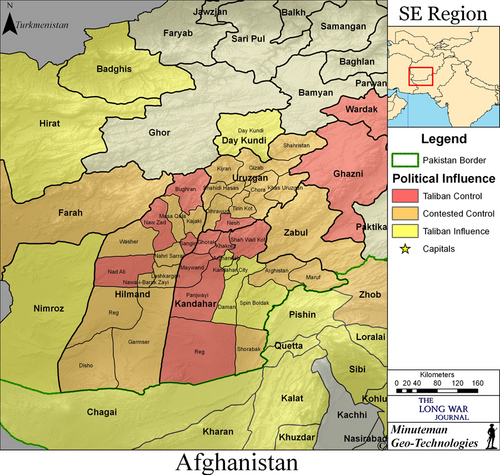Afghan and US forces battle Taliban in northern Helmand stronghold
Monday, June 8, 2009
Afghan commandos and US troops are battling the Taliban for control of a region in northern Helmand province that serves as a command and control center as well as a major drug processing center.
The combined forces launched an attack against the Taliban in the town of Marja in the Nad Ali District late at night on May 18. The town is described by the US military as "a main command node" and a "hub of narcotics processing" for the Taliban in Helmand province. According to Quqnoos, an English language Afghan news outlet, Marja has been under Taliban control for more than a year and a half.
Afghan commandos and US forces took control of the center of the town and targeted the bazaar, which is described as "a nucleus of militant activity." There the forces discovered two "war rooms stocked with maps, communication equipment, Russian-made night vision goggles and US military vehicle parts," as well as a variety of weapons.
The soldiers also discovered a large amount of homemade explosives "packaged into gallon-size drums and prepared for use in vehicle-borne improvised explosive devices," as well as 14,750 kilograms of black tar opium, 11 kilograms of processed heroin, and 30 kilograms of morphine.
Thirty-four Taliban fighters have been killed during what the US military called heavy fighting to control the town. Sixteen fighters were killed in an airstrike in the bazaar as the Taliban attempted to retake control of the town. Six more Taliban fighters surrendered during Coalition raids in the town.
The Taliban have vowed to keep fighting in Marja. "We will never leave Marja and we will fight them [the Afghan and NATO troops] till we are alive," a Taliban spokesman told Quqnoos.
Nad Ali a hub of activity for the Taliban and al Qaeda
Nad Ali is one of several districts in southern Afghanistan in the grip of the Taliban. The district has served as a launch pad for Taliban suicide and conventional attacks against Afghan and Coalition forces in the neighboring provincial capital of Lashkar Gah, as well as for operations in the nearby provinces of Nimroz and Farah, where violence has increased over the past several years. Taliban forces have been launching attacks in the south and southwest with formations numbering in the hundreds of fighters.
Abdullah Sa'id, the commander of the Lashkar al Zil or Shadow Army, mentioned one of these attacks during a statement released in April of this year that outlined the plan by al Qaeda and the Taliban to take control of Afghanistan [see LWJ report, Al Qaeda's Shadow Army commander outlines Afghan strategy].
"A few days ago, hundreds of Taliban fighters attacked Lashkar Gah, the provincial capital of Helmand province and they came very close to hold control over it," he said. "This prompted one of the British commanders in the area to admit that Helmand's bite is too big to be digested by the British presence."
Nad Ali and the nearby Nad Zad district host several Taliban and al Qaeda command and control centers as well as training camps. In the same statement, Sa'id also alluded to these camps.
"The return of al Qaeda organization to Afghanistan [is] stronger than it was before 11 September 2001 in that it has a better safe haven in the border areas [Waziristan] in the northeast and Helmand in the south where it has set up bases to train its cadres and has the support of all the Taliban movement's wings," the statement read.
Background on the Shadow Army
The Shadow Army is al Qaeda's elite paramilitary army [see LWJ report, Al Qaeda's paramilitary 'Shadow Army']. The unit has its roots in the 055 Brigade, which fought conventional battles against the Northern Alliance and US forces in Afghanistan.
The Taliban, al Qaeda, the Haqqani Network, Lashkar-e-Taiba, Harkat-ul-Jihad-al-Islami, Harkat-ul-Mujahideen, Lashkar-e-Jhangvi, and a host of Pakistani jihadi terror groups have joined forces to battle both the Pakistani military in the Northwest Frontier Province and the NATO and Afghan forces in Afghanistan. The Shadow Army contains fighters from each of these terror groups, and trains in camps in the Northwest Frontier Province and the tribal areas.
Sa'id is a Libyan national, a senior US military intelligence official told The Long War Journal. He is thought to have formal military training; however this has not been confirmed. Many senior al Qaeda military commanders have served in their country's military.
Sa'id succeeded Khalid Habib as the leader of the Shadow Army. In October 2008, Habib was killed in a US Predator airstrike in a region in South Waziristan controlled by Pakistani Taliban commander Baitullah Mehsud.
Afghan and US forces battle Taliban in northern Helmand stronghold
[Source: Good Times Society]
posted by tgazw @ 2:19 AM,
![]()
0 Comments:
Multimedia
Top Stories
Sponsored Links
Sponsored Links

Post a Comment